Cree: Difference between revisions
(→MT-G2: highest bin is P0) |
(→MT-G2: add Crelant 7G10 and Solarforce S2200 as first MT-G2 lights) |
||
| Line 38: | Line 38: | ||
==MT-G2== | ==MT-G2== | ||
Large die high power LED has versions that run at 6, 9, or 36 volts with maximum power of 18 watts. LED is 8.9mm x 8.9mm. | Large die high power LED has versions that run at 6, 9, or 36 volts with maximum power of 18 watts, first available around November 2012. The LED is 8.9mm x 8.9mm and the light will be floody compared to the smaller XM-L. The first production lights to use this LED were the Crelant 7G10 and Solarforce S200, introduced in May 2013. The LED is binned at 85°C. The bins shown below have been increased by 15% to give output at 25°C for easier comparison to other LED's. | ||
{|class="wikitable" style="text-align: center; width: 400px;" | {|class="wikitable" style="text-align: center; width: 400px;" | ||
Revision as of 10:14, 24 May 2013

Cree is a LED manufacturing company based in Durham, North Carolina. They produce a number of different models of high output LED's that are widely used in flashlights. They do not actually make flashlights, though some companies will describe their product as a "Cree flashlight." This refers to the LED inside the flashlight.
Cree bins individual models of LED on the basis of total flux or light output, typically measured at 350mA. Bin numbers might be P4, Q2, Q3, Q4, Q5, R2, R3, R4, and R5 with each bin being about 5% additional flux. The P4 is 80 lumens, a Q5 would be 107 lumens, and the R5 bins are 137 lumens. At higher amperage than 350mA, the brightness goes way up, with the XP-G producing 3 times as many lumens at a maximum current of 1500mA.
Cree classifies tints of white LED's as being warm, neutral, and cool, but has recently added "outdoor white" in between and overlapping neutral and cool (4000-5300K). Tints are binned using a system based on the ANSI White standard. Cree's tints subdivide and expand on the ANSI regions giving bins such as cool 1B, neutral 5B1, and warm 7D2, though many other tints and subdivisions are available. Click on the graphic at right to see all of the bins, though not all bins are available.
In addition, Cree produces High CRI LED's, with CRI values of 80, 85, and 90 represented by bins H1, P1, and U1 respectively (separately, L1 represents normal CRI white LED's, and O1 is outdoor white).
Below are output numbers for different currents for the various brightness bins of LED models. There is more information available with the Cree Product Characterization Tool, an online calculator that allows you to look up output based on more factors. The numbers on this page, like those given by the PCT, are based on charts in the LED datasheets.
MC-E
An older 4-die LED available with four of the same color dies or the MC-E Color with four different color dies (white, red, green, blue). The maximum current is 700mA with a Vf of 3.4V, though this varies from one color to another. Bins run from G (240 lumens) to M (430 lumens) at 350 mA. The white quadrant of the MC-E Color is available in cool white (A5) or neutral white (A4).
The MC-E was widely used in high-power flashlights like the EagleTac M2SC4, Fenix TK40, iTP A6 Polestar, and JETBeam M1X with advertised output of up to 700 lumens. The color version is in the Quark RGB (with neutral white or cool white available) but although the LED allows mixing of colors, the Quark RGB is switched to one color at a time.
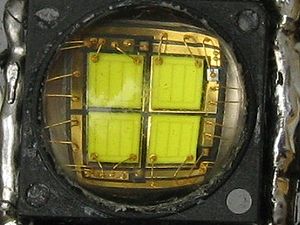
| Bin | 1400mA (350mA/die) 100% |
2800mA (700mA/die) 175% |
|---|---|---|
| H | 280-320 | 490-560 |
| J | 320-370 | 560-648 |
| K | 370-430 | 648-753 |
| M | 430-490 | 753-858 |
| N* | 490-550 | 858-962 |
| P | 550-620 | 962-1085 |
MT-G2
Large die high power LED has versions that run at 6, 9, or 36 volts with maximum power of 18 watts, first available around November 2012. The LED is 8.9mm x 8.9mm and the light will be floody compared to the smaller XM-L. The first production lights to use this LED were the Crelant 7G10 and Solarforce S200, introduced in May 2013. The LED is binned at 85°C. The bins shown below have been increased by 15% to give output at 25°C for easier comparison to other LED's.
| Bin | 1100mA 100% |
1500mA 172% |
3000mA 230% |
|---|---|---|---|
| D0 | 460-506 | 598-658 | 1058-1164 |
| E0 | 506-552 | 658-718 | 1164-1270 |
| F0 | 552-598 | 718-777 | 1270-1375 |
| G0 | 598-644 | 777-837 | 1375-1481 |
| H0 | 644-690 | 837-897 | 1481-1587 |
| J0 | 690-736 | 897-957 | 1587-1693 |
| K0 | 736-782 | 957-1017 | 1693-1799 |
| M0 | 782-828 | 1017-1076 | 1799-1904 |
| N0 | 828-874 | 1076-1136 | 1904-2010 |
| P0* | 874-920 | 1136-1196 | 2010-2116 |
XB-D
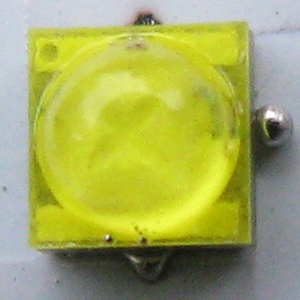
Very compact LED (the die is mounted on a chip 2.45 mm square opposed to 3.45 mm square for XP series) introduced in February 2012, promising lower cost. Should provide similar brightness to XP-E LED's. First available units were warm white with Q2 brightness bin (at 350mA). This LED is used in some budget Ozark Trail 3xAAA lights at Walmart. The XB-D is binned at an operating temperature of 85° C instead of 25°, so in order to directly compare its output to other LED's that are typically binned at 25 degrees, the output numbers in the table below have been increased by 14% from what is shown in the datasheet (see XB-D output for the 85° numbers). Can be driven up to 1000mA. Datasheet, press release.
| Bin | 350mA 100% |
700mA 172% |
1000mA 222% |
|---|---|---|---|
| Q2 | 100-107 | 172-184 | 222-238 |
| Q3 | 107-114 | 184-196 | 238-253 |
| Q4 | 114-122 | 196-210 | 253-271 |
| Q5 | 122-130 | 210-224 | 271-289 |
| R2 | 130-139 | 224-239 | 289-309 |
| R3 | 139-148 | 239-255 | 309-329 |
| R4* | 148-158 | 255-272 | 329-351 |
XM-L
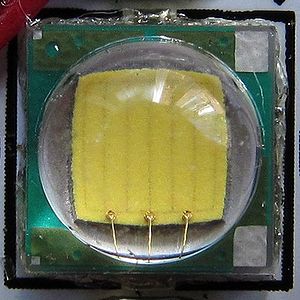
Widely used in high power flashlights, this larger die LED was first available in November 2011, offering efficacy of 160 lumens per watt at 350mA. Output is as high as 340 lumens at 700mA (bin U3, which is still rare) therefore it is more efficient and puts out more light at any current than earlier single-die Cree LED's. However the biggest improvement to overall output is the XM-L can be driven to 3000mA for 1100 lumens of output. Because the XM-L is binned at 700mA, the bin numbers do not correlate exactly to those of the smaller die LED's which are binned at 350mA. The LED die is 2mm x 2mm on a 5mm x 5mm substrate with 6 yellow strips and 3 bonding wires as opposed to the XP-G with 4 strips and 2 bonding wires and the XP-E with 3 strips and 2 bonding wires. The first production lights to feature the XM-L were versions of the ThruNite Catapult V2 (first to ship), EagleTac M3C4, a 4Sevens Quark MiNi, and the JETBeam M1xm, introduced in December 2010, but budget retailer KaiDomain had LED's and P60 drop-ins as well as P60 lights around the same time. Neutral and warm tints began shipping in March 2011. Press release Cree XM-L datasheet
| Bin | 700mA 100% |
1000mA 137.5% |
1500mA 195% |
3000mA 325% |
|---|---|---|---|---|
| T2 | 200-220 | 275-303 | 390-429 | 650-715 |
| T3 | 220-240 | 303-330 | 429-468 | 715-780 |
| T4 | 240-260 | 330-358 | 468-507 | 780-845 |
| T5 | 260-280 | 358-385 | 507-546 | 845-910 |
| T6 | 280-300 | 385-413 | 546-585 | 910-975 |
| U2 | 300-320 | 413-440 | 585-624 | 975-1040 |
| U3* | 320-340 | 440-468 | 624-663 | 1040-1105 |
XM-L2
Same 5mm x 5mm size as the original XM-L but with up to 20% more output. Introduced in December 2012. Like the XP-G2, the XM-L2 is silver on top, has two bonding wires, and the die has dots instead of lines. The XM-L2 is significantly larger than the XP-G2 and has a round hole at the upper left as opposed to the XP-G2's square hole. The LED's are binned at 85°C, so the values shown below have been increased by 13.7% to make comparisons with other LED's binned at 25°C easier. The first production lights to feature the XM-L2 were the ThruNite Catapult V3 and TN31 in January 2013, followed by a number of Xeno lights which also had options for neutral tints in Feburary. Press release.
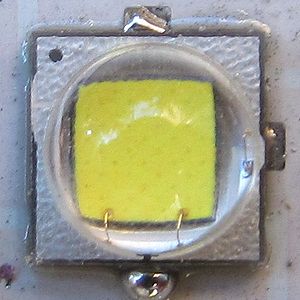
| Bin | 700mA 100% |
1000mA 138% |
1500mA 194% |
3000mA 328% |
|---|---|---|---|---|
| S4 | 186-196 | 256-268 | 360-377 | 612-641 |
| S5 | 196-207 | 268-284 | 377-400 | 641-679 |
| S6 | 207-227 | 284-313 | 400-439 | 679-746 |
| T2 | 227-250 | 313-343 | 439-483 | 746-820 |
| T3 | 250-273 | 343-375 | 483-528 | 820-895 |
| T4 | 273-296 | 375-406 | 528-571 | 895-970 |
| T5 | 296-318 | 406-438 | 571-615 | 970-1044 |
| T6 | 318-341 | 438-468 | 615-659 | 1044-1119 |
| U2* | 341-364 | 468-500 | 659-703 | 1119-1193 |
XP-C
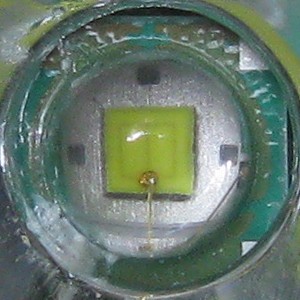
A lower current version of the XP-E with a smaller die. Maximum current 500mA and Vf of 3.5V. Bins up to Q4 (100 lumens) in cool white, Q2 in neutral white (84.7 lumens) and P3 in warm white (73.9 lumens). Looks like the XP-E, but the die has 2 yellow strips and 1 bonding wire instead of 3 strips and 2 bonding wires. The XP-C is used in the Streamlight Microstream and some Mini Maglites.
XP-E
Introduced in Fall of 2008, the XP-E shrunk the XR-E by 80% (though it uses the same die), now 3.45 mm square. It is available, in white (cool, neutral, and warm), blue, green, amber, red, and red-orange. For cool white, bins are Q3, Q4, Q5, R2 and R3 with output from 93.9 to 122 lumens. Neutral white bins are from P4 to Q4 (100 lumens min) and warm white bins range from P2 to Q2 (87.4 lumens min).
This LED is used in the NiteCore Defender Infinity, early Quarks (R2, neutral whites used a Q3), the iTP A series EOS and S series lights, EagleTac P100 and T100 series.
The XP-E has 3 strips on the die as opposed to 2 on the XP-C and 4 on the XP-G.
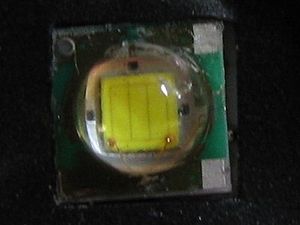
| Bin | 350mA 100% |
700mA 170% |
1000mA 220% |
|---|---|---|---|
| P4 | 80.6-87.4 | 137-149 | 177-192 |
| Q2 | 87.4-93.9 | 149-160 | 192-207 |
| Q3 | 93.9-100 | 160-170 | 207-220 |
| Q4 | 100-107 | 170-182 | 220-233 |
| Q5 | 107-114 | 182-194 | 233-251 |
| R2 | 114-122 | 194-207 | 251-268 |
| R3 | 122-130 | 207-221 | 268-286 |
| R4* | 130-139 | 221-236 | 286-306 |
XP-E2
Introduced in September 2012, this redesign is similar to the XP-G2. Cree claims up to 20% more output than the original XP-E at half the cost in terms of lumens per dollar. Press realease, datasheet. The XP-E2 is binned at 85°C, but for ease of comparison, the output numbers below are increased by 16% to get 25° values.
| Bin | 350mA 100% |
700mA 171% |
1000mA 218% |
|---|---|---|---|
| P2 | 78.0-85.7 | 133-147 | 171-187 |
| P3 | 85.7-93.5 | 147-160 | 187-204 |
| P4 | 93.5-101 | 160-174 | 204-222 |
| Q2 | 101-109 | 174-187 | 222-238 |
| Q3 | 109-116 | 187-198 | 238-253 |
| Q4 | 116-124 | 198-212 | 253-270 |
| Q5 | 124-132 | 212-226 | 270-289 |
| R2 | 132-142 | 226-242 | 289-309 |
| R3* | 142-151 | 242-258 | 309-329 |
XP-G
Same size package as the XP-E, but with a larger die. Therefore the resulting beam has a little more flood. It is available in varying output bins from R2 to S3 (S2 and S3 are rare and not always the best tints). Maximum current is 1500mA and Vf of 3.3V with efficacy of 141 lumens per watt. Cree XP-G datasheet, press release.
The XP-G R5 began widespread use in 2010 after being adopted early by 4Sevens and EagleTac. The limited edition titanium Quarks were among the first to use the XP-G, with an R4 bin. S2 bins became available in November 2010 but only in Quark and iTP special edition lights. Special edition matte-finish titanium Quark Mini and Turbo models were the first to feature S3 bins, shipping in December 2010.
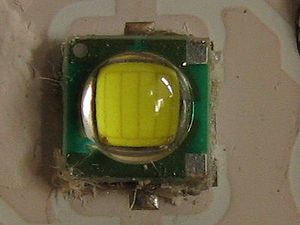
| Bin | 350mA 100% |
700mA 187% |
1000mA 250% |
1500mA 333% |
|---|---|---|---|---|
| R2 | 114-122 | 213-228 | 285-305 | 380-406 |
| R3 | 122-130 | 228-243 | 305-325 | 406-433 |
| R4 | 130-139 | 243-260 | 325-348 | 433-463 |
| R5 | 139-148 | 260-277 | 348-370 | 463-493 |
| S2 | 148-156 | 277-292 | 370-390 | 493-520 |
| S3* | 156-164 | 292-307 | 390-410 | 520-547 |
| S4 | 164-172 | 307-322 | 410-430 | 547-573 |
XP-G2
Introduced in July 2012, the XP-G2 is an all new design with the same size as the earlier XP-G. Like Cree's other 2012 offerings, the XP-G2 is binned at 85°C, but for ease of comparison, output shown on this page is increased by 13% to get 25° values. In August 2012, Foursevens was the first company to adopt this LED, claiming up to 20% more output and a 5% smaller hotspot for greater throw compared to the same models using a XP-G. Press release, Datasheet
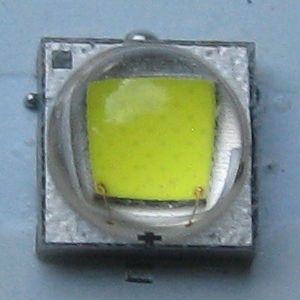
| Bin | 350mA 100% |
700mA 183% |
1000mA 243% |
1500mA 329% |
|---|---|---|---|---|
| Q4 | 113-121 | 206-220 | 275-294 | 373-399 |
| Q5 | 121-129 | 220-235 | 294-313 | 399-425 |
| R2 | 129-138 | 235-252 | 313-336 | 425-454 |
| R3 | 138-147 | 252-268 | 336-357 | 454-485 |
| R4 | 147-157 | 268-287 | 357-382 | 485-518 |
| R5* | 157-170 | 287-310 | 382-412 | 518-558 |
XR-C
Same size as XR-E (7mm x 9mm) but is designed for less current (500mA max). The die itself is smaller than the XR-E (same as the one in the XP-C). The maximum bin is Q2 with 87.4 lumens for cool white. It is available in white (cool, neutral, and warm) as well as royal blue, blue, green, amber, red-orange, and red. Vf is 3.5 volts at 350mA. Identifiable by the metal ring around the dome and a LED die with only two yellow strips and one bonding wire.
The XR-C is used in retail lights made by Coleman, River Rock, and Energizer.
XR-E
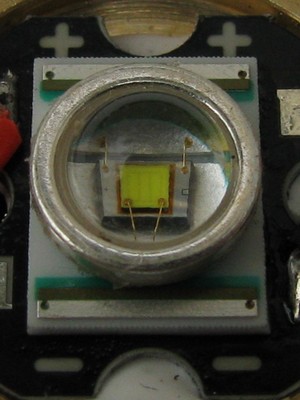
Introduced in the Fall of 2006 the XR-E was widely used in a number of different flashlights, with cool white, neutral white, and warm white colors available in addition to blue, royal blue, and green. Common bin numbers are P4, Q2, Q3, Q4, Q5, and R2 with increasing output from 80 lumens to 122 lumens at 350 mA and a Vf of 3.3V, but with much greater output available with higher currents. The size is 7 mm x 9 mm and you will often see this referred to as a 7090 XR-E. The die itself was available as the EZ1000 at first and then the smaller EZ900. Because the EZ900 can have the same overall output as the larger EZ1000 but in a smaller form, it should provide 23% greater intensity and throw (the EZ1000 is 1 mm square and the EZ900 is 0.9 mm square).
This LED was very widely used, featured in flashlights by Fenix, JETBeam, NiteCore D10, and EagleTac P20 and T20 series, and is still available in some budget lights. The neutral white version was used in Nitecore EZ series. It is easily recognized by the metal ring around the die with 3 yellow strips and 2 bonding wires.
XT-E
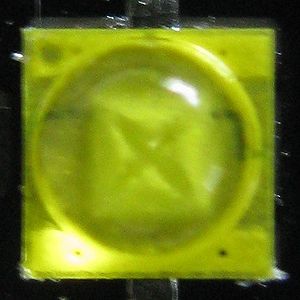
Introduced in February 2012, the XT-E has the same size chip as the XP series but seems to have a wider viewing angle for more flood and less throw. Can be driven up to 1.5A and available in bins up to R5 (at 350mA). This LED is binned at an operating temperature of 85° C instead of 25°, so in order to directly compare its output to other LED's that are typically binned at 25 degrees, the numbers in the table below have been increased by 14% (see XT-E output for the 85° numbers). Cree introduced the XT-E as a low-cost, high efficiency LED capable of 148 lumens per watt at 350mA, offering higher lumens per dollar. The LED is not a flat square, but has an X shaped hill on the surface. The beam is like a small XM-L with a large hotspot and some varying tint across the beam. EagleTac announced that the XT-E would be an option in its D25 clicky series in April 2012, but XT-E lights were never actually released, supposedly due to beam quality issues. At about the same time, KaiDomain offered P60 drop-ins and flashlights with the XT-E. Cree uses the XT-E LED in its line of household light bulbs, introduced in 2013. Datasheet, press release.
| Bin | 350mA 100% |
700mA 178% |
1000mA 230% |
1500mA 302% |
|---|---|---|---|---|
| Q5 | 122-130 | 217-231 | 280-299 | 369-404 |
| R2 | 130-139 | 231-247 | 299-320 | 404-421 |
| R3 | 139-148 | 247-263 | 320-341 | 421-448 |
| R4 | 148-158 | 263-282 | 341-365 | 448-479 |
| R5* | 158-169 | 282-300 | 365-388 | 479-510 |
| S2 | 169-178 | 282-316 | 388-409 | 510-537 |